
The Jabez Partridge Homestead is an historic farmstead at 81 Partridge Road in Gardner, Massachusetts. With its oldest part dating to about 1772, it is one of the oldest buildings in the town, built by an early settler, and is a good example of Federal period architecture. It was listed on the National Register of Historic Places in 1979.

The Ezra Wood–Levi Warner Place is an historic house at 165 Depot Road in Westminster, Massachusetts. The oldest portion of the house, now an ell attached to the rear of the main block, was built in 1759 by Nathaniel Merrill, and is one of the town's oldest surviving structures. The house has served as a hotel, stagecoach stop, post office, and as a stop on the Underground Railroad. The house was listed on the National Register of Historic Places in 1983.

The Elisha Allen House is a historic house located at 108 Homestead Avenue in Rehoboth, Massachusetts.
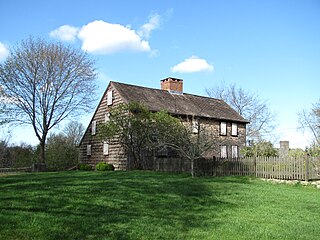
The Bradford House, also known as the Major John Bradford Homestead, is a historic house at 50 Landing Road in Kingston, Massachusetts. The Jones River Village Historical Society owns the house, and operates it as a historic house museum. The oldest portion of this 2+1⁄2-story wood-frame house was built c. 1714; this was the western portion of the house, including what is now the central chimney. Documentary evidence suggests the building was expanded to its present width c. 1750. The house was restored to its 18th-century appearance in 1921 by George Francis Dow, around the time it was purchased by the Jones River Village Historical Society. The property includes an English barn that was moved to the site in 2002.
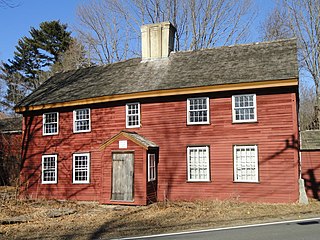
The Benjamin Abbot House or Abbot Homestead is a historic house at 9 Andover Street in Andover, Massachusetts, USA. The house was built in 1711. It was listed on the National Register of Historic Places in 1975.
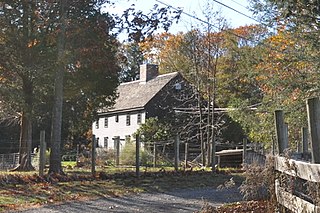
The Isaac Goodale House is a historic house in Ipswich, Massachusetts. Built about 1700, the house has many original First Period elements, despite its relocation to its present location in 1928. The house was listed on the National Register of Historic Places in 1990, and is the subject of a preservation easement held by the Ipswich Historic Commission.

The Deacon Edward Putnam Jr. House is a historic First Period house in Middleton, Massachusetts, United States. The oldest portion of the house, its right (east) side and the central chimney, were built c. 1705, probably by Deacon Edward Putnam Sr. By 1718, Edward Jr. occupied the house with his family, by which time it had been expanded with rooms to the west. The house facade had, until renovations in the 1960s, an unusual three bay configuration, with two windows on the west side of the chimney and one to its right. The renovations in the 1960s added a lean-to section to the rear of the house, beyond which a single story ell connects the house to a series of barns.

The Daniel Nichols Homestead is a historic home in Reading, Massachusetts. The oldest portion of this timber-frame house was built in the early 1740, with vernacular Georgian styling. The house is five bays wide and two deep, with a rear shed-roof extension giving the house a saltbox appearance. An ell was added in the mid-19th century. The main architectural detail is the front door surround, which features sidelight windows and recessed, paneled pilasters supporting a tall entablature.

The Smith-Thaxter-Merrifield House is an historic house at 158 Holden Street in Worcester, Massachusetts. Built c. 1741 and probably altered in the late 18th century, it is one of the oldest houses in the city, and has only undergone minimal alteration. It is also a rare local example of a hip-roof central-chimney house. It was listed on the National Register of Historic Places in 1980.
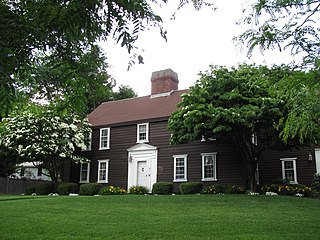
The Hammond House is an historic house located at 9 Old Orchard Road in the village of Chestnut Hill in Newton, Massachusetts. With an estimated construction date of 1645-1730, it is believed to be the oldest house in Newton. It is also a rare example of a First Period house that was started as a single cell, that was expanded to five bays later in the First Period; such expansion usually took place later in the 18th century, during the Georgian period. The house has been extended multiple times over the intervening centuries; the original core now lies just east of the main entrance. The original house was built by Hon. Ebenezer Stone when he moved from the Stone homestead at Mount Auburn in Watertown.

Lucy Goodale Thurston was a Protestant missionary and author. She was the wife of Asa Thurston and was one of the first American Christian missionaries to Hawaii. She is noted for her letters documenting her life and missionary works in the islands.

The Avery Homestead is a two-story Colonial-style home in Ledyard, Connecticut that was built circa 1696. Evidence suggests that the house may have begun as a single-story, one-room house and later expanded to a two-story, two-room house by 1726. The house underwent major additions and renovations by Theophilus Avery and later his grandson, Theophilus Avery. In the mid-1950s, Amos Avery began a decade-long restoration effort to return the house to its 18th-century appearance. The Avery Homestead is historically significant as a well-preserved example of an 18th-century farmhouse with fine craftsmanship. The home is also historically important because more than twelve generations of the Avery family have resided there over the course of three centuries. The Avery Homestead was listed on the National Register of Historic Places in 1992.

The Clark Homestead is a historic house on Madley Road in Lebanon, Connecticut. Built c. 1708, it is believed to be Lebanon's oldest building. It was owned in the late 18th century by James Clark, a veteran of the American Revolutionary War. The house was listed on the National Register of Historic Places on December 1, 1978.

The Edward Cogswell House, also known as the Bliss House, is a historic house at 1429 Hopeville Road in Griswold, Connecticut. With its oldest portion estimated to date to 1740, it is one of Griswold's few 18th-century buildings. It was added to the National Register of Historic Places on December 15, 1993.
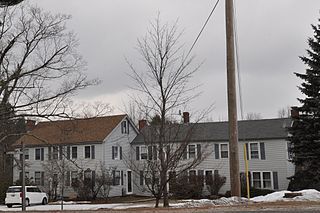
The Isaac Greenwood House is a historic house on New Hampshire Route 101 in eastern Dublin, New Hampshire, United States. The oldest portion of this house was built c. 1784 by Isaac Greenwood, a veteran of the American Revolutionary War. The house, a good example of additive architecture of the 19th century, was listed on the National Register of Historic Places in 1983.

The Learned Homestead is a historic farmstead on Upper Jaffrey Road in Dublin, New Hampshire. Built about 1790, it is a well-preserved example of an early farmstead, and one of the few surviving in the town from the 18th century. It is also noticeable for its association with the locally prominent Learned family, and for the summer estate movement of the early 20th century. The house was listed on the National Register of Historic Places in 1983.

The Ivory Perry Homestead is a historic house at the corner of Valley and Dooe roads in Dublin, New Hampshire. Built about 1767 and enlarged about 1820, it retains many original features from its period of construction. It was built by Ivory Perry, one of Dublin's first white settlers. The house was listed on the National Register of Historic Places in 1983.

The Abijah Richardson Sr. Homestead is a historic house at 359 Hancock Road in Dublin, New Hampshire. Built about 1795, it is one of Dublin's oldest houses, built by Abijah Richardson Sr., one of the town's early settlers and progenitor of a locally prominent family. The house was listed on the National Register of Historic Places in 1983.

The Nutting Homestead is a historic farm complex on Maine State Route 121, south of the center of Otisfield, Maine. The property has been owned by the Nutting family and its descendants since the late 18th century and exemplifies the adaptive use of farm properties over time. The oldest portion of the farmhouse dates to 1796, and other buildings in the complex date mainly to the 19th century. The property was listed on the National Register of Historic Places in 1974.

The Phineas Thurston House is a historic house on Old Silo Road in Barnet, Vermont. Built about 1787, it is one of the oldest surviving houses in northeastern Vermont, and one of the best-preserved early houses in Barnet. It was listed on the National Register of Historic Places in 1989.























